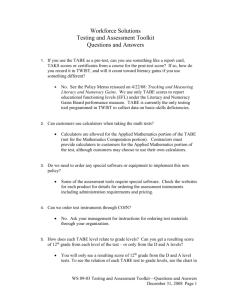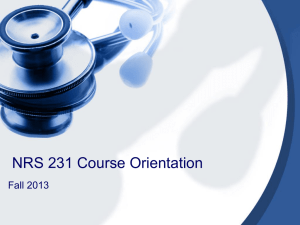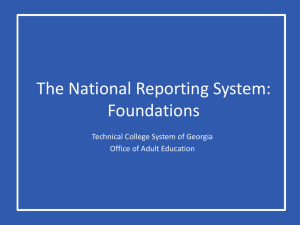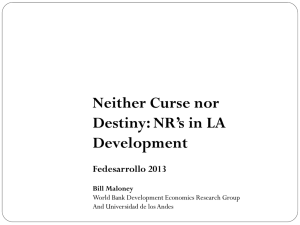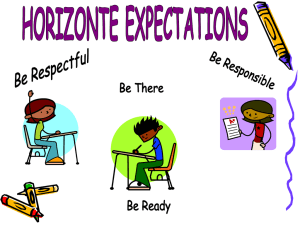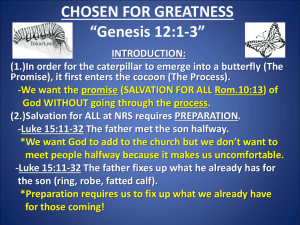TABE Train the Trainer 2013 power point I
advertisement
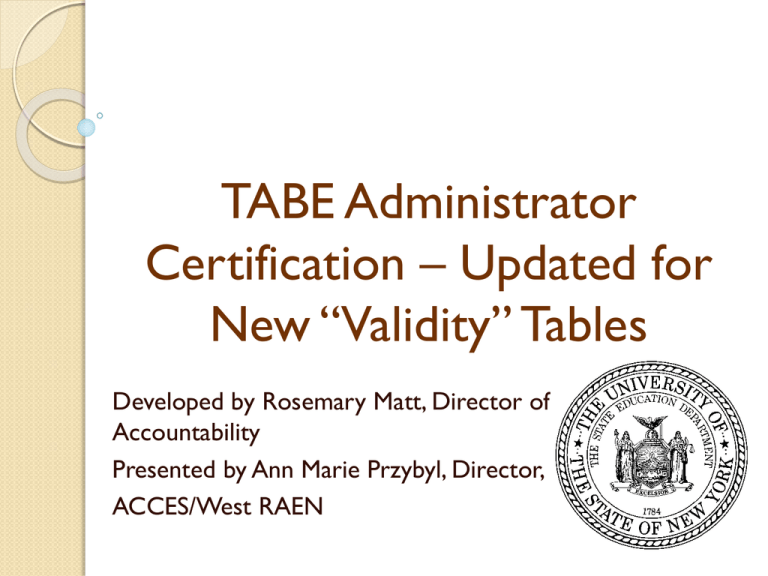
TABE Administrator Certification – Updated for New “Validity” Tables Developed by Rosemary Matt, Director of Accountability Presented by Ann Marie Przybyl, Director, ACCES/West RAEN Today’s Objectives Preparation for providing TABE training to TABE Test Administrators Today will be a combination of demonstrating the training activities and discussion about audience participation Today’s Objectives Morning session: Learn proper test administration and effective use of the scoring tables Clarify the relationship between TABE test scores and NRS levels Utilize the NYSED Validity Tables Afternoon session: Hands on activities emphasizing how TABE assessment scores inform teacher instruction Strategizing for effective post testing TABE Levels A Advanced D Difficult M Moderate E Easy L Language Two Forms 9 and 10 Pre and Post test must toggle the forms Multiple Post tests must toggle between the two forms Form 9 and Form 10 are considered of equal challenge One is not preferred nor required over the other! Two sections required by NYSED Math – Full Battery Reading – Full Battery Other sections may be provided at the discretion of the program administrator Activity one: Exploring the TABE test levels Take 10 minutes to browse through each TABE Level test booklet What are the commonalities? What are the differences? Commonalities: Same number of questions (with the exception of the L Level) All multiple choice format Directions are the same Time on each section is equal across all levels Differences: Front cover color on each Level is different Font changes as levels increase White space decreases as levels increase Complexity and length of the text for questions increases Graphics prominent in Lower Levels TABE Locator Test Required by New York State under NRS Policy Must be entered into student folder The cut points are ONLY guidelines Use the cut points along with any knowledge of the examinee’s previous performance to help determine placement into TABE levels TABE Locator Test Tip Locator is not recorded in ASISTS If Locator places student on the “A” Level test, reconsider especially if student is new to your adult education program If you know something about the student, base your judgment on that knowledge and not just the Locator TABE Locator Test Tip Locator must be timed and administered according to the Guidelines on pages 23 – 32 in the TABE ® “Complete Battery Test Directions”. TABE Locator: • Score of 7 • Recommend an E • Score of 10 • Recommend a D TABE Levels Required by NYSED If an L Level is used, it can only show gain from Level 1 to Level 2, then the student must transition to the TABE Level E test If Locator places student on the “A” Level test, reconsider especially if student is new to your adult education program TABE Levels Need Not Match! Students may be tested on one level for Math and a different level for Reading TABE Online Users: the administrator may (and should) override the Level chosen if the need arises (post test level is chosen by the software in TABE Online product) Administration of the TABE Programs should have at least one copy of the Test Directions/Complete Battery and Locator Test, All Levels, Forms 9 & 10 Administration of the TABE Tests must be administered in a contiguous flow: EXAMPLE: ◦ Pre test on an M, then Post may be an M, D, or an A (the A Test is not required for NYSED funded programs, it is optional) ◦ Pre test on an M, cannot Post on an E Administration of the TABE Under NRS Policy • TABE 9 • TABE 10 Must be used in a series • Pre Test on 9 • Post Test on 10 • Or Visa Versa Exception Audio version of the TABE is published in only one form When students are assessed with the audio version, the administrator will not have the ability to move between forms Must send the post test scores to Rosemary Matt in the office of accountability so she can convert the scores appropriately. Testing Times 9 & 10 Series: Reading Mathematics 50 minutes ◦ Computation 24 minutes ◦ Applied Mathematics 50 minutes Testing Times 9 & 10 Series: Test Administrator must read the directions to all test takers Regardless of any Level test taker, directions are identical Administration of the TABE Timed Tests ◦ Test should be scheduled for time frames suitable for completing each section of the test Breaks should be given between sections of the test NOT during the sections Administration of the TABE If the test is interrupted (ie. a student leaves before the section is complete, a fire drill interrupts the test, student is taken ill) ◦ The test results are rendered invalid ◦ Retest must be scheduled Administration of the TABE Testing environment must be conducive to student comfort Quiet Organized Comfortable Seating Minimize Distractions Calculator Use on the TABE Remember to teach your students the proper use of the calculator If you are using a scientific calculator you must provide guided practice A four-function calculator (like that from the dollar store) functions very differently! Calculator Use: Calculator made available during the Applied Mathematics section Mandated by the National Reporting System (NRS) Program must provide the calculator, must not be one the student carries in Know in advance the type of calculator that is available to the student Four Function Calculator Scientific Calculator TI-30 xs as required on the TASC Why is a Calculator Necessary? Calculator made available during the Applied Mathematics section This section is assessing the student’s ability to implement mathematical theory No need to assess the student’s ability to calculate numbers Cannot be used on the Computational Math Section Score Sheets Mandatory documentation: • Name • Examiner • School • Test Date • Test Form Original score sheet MUST be placed in student’s folder TABE Modifications for Learning Disabled Students Most Important to Remind: Students must have a DOCUMENTED clinical diagnosis of a Learning Disability within the past 5 years Bear in mind, some modifications, even if documented on an IEP, would render the TABE results invalid Remember, the purpose of the TABE is to ASSESS the student’s SKILLS! TABE Modifications for Learning Disabled Students Two instances for modifications: Category 1: Students may take the test alone or in a study carrel. Category 2: Students may use extra time when taking the test or may take sections of the test at different times or on different dates. TABE Modifications for Learning Disabled Students Special note: Please note that calculators cannot be used when taking the mathematics computation section of the test Calculators may be used by any test taker on the Applied Mathematics component only TABE Modifications for Disabled Students If a student is blind and needs the test read to them, you must use the TABE audio test or the TABE in braille There is only one form of the test (only Form 9, no 10) so when you are administering a post test, you must notify the Accountability Specialist, Rosemary Matt so she can manage the scores appropriately in ASISTS The Norming Process Norm-referenced assessment is the process of evaluating (and grading) the skills students possess by comparing against the performance of peer groups When an assessment is normed, the publisher will note the reference groups that were used as the “peer group” The Norming Process For the TABE, the following Reference Groups were used in the Norming Process: Reference Groups ABE Adult Basic Education Enrollees VO Vocational/Technical School Enrollees A/JO Adult/Juvenile Offenders COL College Students The Norming Process Acronyms you will see on the Norming Page Scores NC Number-Correct Score SS Scale Score SEM Standard Error of Measurement GE Grade Equivalent P Percentile Rank S Stanine Basic Bell Curve Most Desirable Scores NYS Valid Score Range • The Standard Error of Measure is the smallest at the middle of the score range…this is the center of that Bell Curve! • This section represents the most reliable scores on an assessment Next Tool: New York State’s Validity Tables … NRS Levels- 2-5 NRS Levels- 1-4 Grade Level Equivalents – 2.2-9.9 Grade Level Equivalents -1.3-6.9 TABE E NRS Levels- 1-4 Grade Level Equivalents -0-6.9 TABE M TABE D NRS Levels- 1-5 NRS Levels- 2-6 Grade Level Equivalents -1.3-9.9 Grade Level Equivalents -2.2-12.9 National Reporting System Educational Functioning Levels To show Educational Gain in the NRS System, the student must achieve scores that move them from one Educational Functioning Level to the next A total of 6 Levels Gain is calculated on the lower score ONLY NRS Level National Reporting System (NRS) Levels Grade Level Equivalents 1 Beginning ABE Literacy 0 – 1.9 2 Beginning Basic Education 2 – 3.9 3 Low Intermediate Basic Education 4 – 5.9 4 High Intermediate Basic Education 6 – 8.9 5 Low Adult Secondary Education 9 – 10.9 6 High Adult Secondary Education 11 – 12.9 Educational Functioning Levels These descriptors are especially useful when helping students understand their TABE scores. They outline the skills that are associated with each of the Grade Levels Please note: The Maximum valid Grade Equivalent on the Level L test is a 3.9 GE If a student needs to move from NRS Level 2 to NRS Level 3, they cannot do that on a Level L test! Please note: The Maximum valid Grade Equivalent on the Level E test is a 6.9 GE If a student needs to move from NRS Level 4 to NRS Level 5, they cannot do that on a Level E test! Cannot use a Level E to move from NRS Level 4 to NRS Level 5! Please note: The Maximum valid Grade Equivalent on the Level M test is a 9.9 GE If a student needs to move from NRS Level 5 to NRS Level 6, they cannot do that on a Level M test! Cannot use a Level M to move from NRS Level 5 to NRS Level 6! To Make a Wise Decision Regarding Which Form and Level of the TABE, the Test Administrator must have the following tools: Valid Score Ranges NRS Educational Functioning Level Chart Remember NRS Rules! Students are measured for Educational Gain by their LOWEST skill level The gain is measured in whichever TABE score is LOWER Either Math or Reading! Measuring Educational Gain One Educational Gain per fiscal year per student ◦ More testing desired? ◦ Use a non-NRS test ◦ Recommendation: Test Ready Curriculum Associates, LLC LiteracyLink McGraw Hill/Contemporary Students with invalid test scores Note: When the Scale Score, GE, and NRS Level is zeroed out (all zeros), the student’s score fell outside the valid range Students with invalid test scores Note: When an asterisk (*) appears next to the TABE Level, this indicates that either the FORM or LEVEL was an incorrect choice Scenarios Student Pre Tests on a TABE Read, form 9, Level E with 45 correct. •Is this a NYS valid score? •Yes, the range is 0 - 49 •What NRS Level is this score? •The Grade Equivalent is a 6.2 which is an NRS Educational Functioning Level 4 •What NRS Level must the student move into to show gain? •NRS Educational Functioning Level 5 Scenarios Student Pre Tests on a TABE Read, form 9, Level E with 45 correct. •What Level TABE test should be administered? •The student must achieve at least at 9.0 Grade Equivalent to demonstrate gain, that is not even possible on a Level E test so the Post Test must be a Level M •What form of the Post Test? •The Form must be the opposite of the pre test which was a form 9, so the post test must be a form 10 Scenarios Student Pre Tests on a TABE Read, form 10, Level M with 30 correct. •Is this a NYS valid score? •What NRS Level is this score? •What NRS Level must the student move into to show gain? •What Level TABE test should be administered? •What form of the Post Test? Scenarios Student Pre Tests on a TABE Read, form 9, Level D with 41 correct. •Is this a NYS valid score? •What NRS Level is this score? •What NRS Level must the student move into to show gain? •What Level TABE test should be administered? •What form of the Post Test? Scenarios Student Pre Tests on a TABE Read, form 10, Level M with 48 correct. •Is this a NYS valid score? •What NRS Level is this score? •What NRS Level must the student move into to show gain? •What Level TABE test should be administered? •What form of the Post Test? Scenarios Student Pre Tests on a TABE Read, form 9, Level E with 11 correct. •Is this a NYS valid score? •What NRS Level is this score? •What NRS Level must the student move into to show gain? •What Level TABE test should be administered? •What form of the Post Test?
